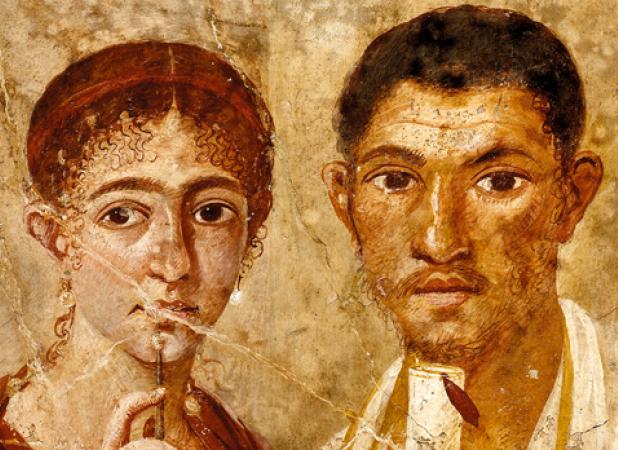The British Museum in London’s ‘Life and Death in Pompeii and Herculaneum’ exhibition brings together over 250 objects from the two Roman cities, many of which have never before been seen outside Italy.
The objects include recent discoveries as well as celebrated finds from earlier excavations. The exhibition aims to give visitors a taste of daily life in the cities that were buried by a volcanic eruption of Mount Vesuvius in just 24 hours in 79 AD. It presents items in a domestic context to help transform museum artefacts into everyday possessions. It explores the lives of individuals in Roman society: businessmen, powerful women, freed slaves and children. One stunning example of the material in the exhibition is a wall painting from Pompeii showing the baker Terentius Neo and his wife, holding writing materials showing they are literate and cultured. Importantly their pose and presentation suggests they are equal partners, in business and in life.
The show includes casts from in and around Pompeii of some of the victims of the eruption. A family of two adults and their two children are huddled together, just as in their last moments under the stairs of their villa. The most famous of the casts displayed is of a dog, fixed forever at the moment of its death as the volcano submerged the cities. In an unprecedented move, the Soprintendenza Speciale per i Beni Archeologici di Napoli e Pompei (Archaeological Superintendency of Naples and Pompeii) has loaned six pieces of wooden furniture from Herculaneum. The items were carbonized by the high temperatures of the ash that engulfed the city and are extremely rare finds that would not have survived at Pompeii – showing the importance of combining evidence from the two cities. The furniture includes a linen chest, an inlaid stool and even a garden bench. Perhaps the most moving piece is a baby’s crib that still rocks on its curved runners.
Located on the Bay of Naples in southern Italy, Pompeii was the industrial hub of the region whereas Herculaneum was a small seaside town. The catastrophe ended the life of the cities but at the same time preserved them until rediscovery by archaeologists nearly 1700 years later. Owing to their different locations, Pompeii and Herculaneum were buried in different ways, which has affected the preservation of materials at each site. Work continues at both sites and recent excavations at Herculaneum have uncovered beautiful artefacts, many of which will be displayed to the public for the first time at the exhibition, such as finely sculpted marble reliefs, intricately carved ivory panels and fascinating objects found in one of the city’s drains.
‘Life and Death in Pompeii and Herculaneum’ runs from 28 March to 29 September 2013. Admission charge is £15 plus a range of concessions. Tickets can be booked online.









